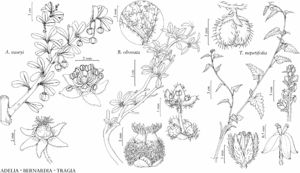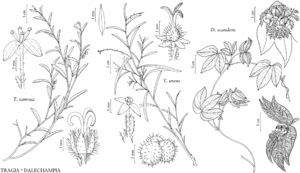Tragia
Sp. Pl. 2: 980. 1753.
Herbs, subshrubs, or vines, perennial, monoecious [dioecious]; hairy, hairs unbranched, always some stinging (sometimes inconspicuous except on ovaries and capsules), sometimes glandular; latex absent. Leaves deciduous, alternate, simple (usually 3-foliolate in T. laciniata); stipules present, persistent; petiole present, glands absent; blade usually unlobed, sometimes lobed basally (sometimes deeply 3-lobed in T. laciniata) [palmately lobed], margins serrate, crenate, dentate, or entire, laminar glands absent; venation pinnate or palmate at base, pinnate distally [palmate]. Inflorescences bisexual (pistillate flowers proximal, staminate distal) [unisexual], axillary, terminal, or leaf-opposed, racemes [rarely with single pistillate branch]; glands subtending each bract 0. Pedicels present, staminate with persistent base, pistillate elongated in fruit. Staminate flowers: sepals 3–5, usually green, sometimes reddish green, not petaloid, valvate, distinct; petals 0; nectary absent [present]; stamens 2–6 (–10) [–25], distinct or connate basally (connate 1/2 length in T. nigricans); pistillode present [absent]. Pistillate flowers: sepals 6, usually green, sometimes reddish green, not petaloid, connate basally; petals 0; nectary absent; pistil 3-carpellate; styles 3, connate basally to 1/2 [most of] length, unbranched. Fruits capsules, usually 3 carpels maturing, except often 1 maturing in T. brevispica. Seeds globose to ovoid; caruncle absent.
Distribution
United States, Mexico, West Indies, Central America, South America, Asia, Africa, Australia, primarily tropical and subtropical regions
Discussion
Species ca. 175 (15 in the flora).
Tragia is a taxonomically difficult genus that is characterized by stinging hairs. Although many species of Tragia are twining vines, most species in the flora area are subshrubs or herbs. Some species are used medicinally for their anti-inflammatory, analgesic, vermifugic, and antihyperglycemic properties. Two sections are represented in the flora area: Tragia and Leptobotrys (Baillon) Müller Arg. Molecular phylogenetic analysis (W. M. Cardinal-McTeague and L. J. Gillespie, unpubl.) suggests that Tragia is polyphyletic and that sect. Leptobotrys (T. smallii, T. urens) should be segregated as a distinct genus; these results are supported by pollen morphology (L. J. Gillespie 1994). Tragia volubilis Linnaeus was collected from Florida once (1842–1848, F. Rugel, US), but has not been collected there since and is presumed extirpated in the flora area. This species is widespread in the Caribbean and Latin America.
Selected References
Lower Taxa
Key
| 1 | Inflorescence glands stipitate. | > 2 |
| 2 | Fruiting pedicels 3–7 mm; leaf blades narrowly ovate to lanceolate, bases shallowly cordate to truncate; persistent base of staminate pedicels 0.3–0.7 mm; stigmas smooth to undulate; Texas. | Tragia glanduligera |
| 2 | Fruiting pedicels 7–11 mm; leaf blades ovate to triangular-ovate, bases deeply cordate; persistent base of staminate pedicels 1.8–2 mm; stigmas undulate to subpapillate; Arizona. | Tragia jonesii |
| 1 | Inflorescence glands absent or sessile (T. nepetifolia and T. ramosa). | > 3 |
| 3 | Capsules 11–13 mm wide; leaf blades 4.5–10(–13) cm, base cordate; petioles 15–85 mm; stamens 3. | Tragia cordata |
| 3 | Capsules 4–11 mm wide (9–13 mm in T. smallii); leaf blades 1–8(–10) cm, base acute, obtuse, subcuneate, cuneate, truncate, subcordate, cordate, subhastate, or hastate; petioles 0–38(–41) mm; stamens 2–6(–10). | > 4 |
| 4 | Stamens 2. | > 5 |
| 5 | Leaf blades orbiculate to elliptic, margins serrate to crenate. | Tragia smallii |
| 5 | Leaf blades usually oblanceolate to linear, sometimes elliptic, margins entire or irregularly sinuate. | Tragia urens |
| 4 | Stamens 3–6(–10). | > 6 |
| 6 | Leaves usually 3-foliolate, sometimes 3-lobed nearly to base. | Tragia laciniata |
| 6 | Leaves simple, usually unlobed, sometimes lobed basally. | > 7 |
| 7 | Stems purple-green to reddish black or brownish red to maroon-green; staminate flowers 2–5 per raceme. | > 8 |
| 8 | Leaf blades acicular to narrowly oblong, 1–6 cm, margins usually entire, sometimes serrulate, petioles 0.5–2 mm; stamens connate basally; capsules 4–5 mm wide. | Tragia leptophylla |
| 8 | Leaf blades oblong to oblanceolate, 3–7 cm, margins coarsely serrate, petioles 1–5 mm; stamens connate 1/2 length; capsules 6–7 mm wide. | Tragia nigricans |
| 7 | Stems green, whitish green, reddish green, dark green, or gray-green; staminate flowers 2–80 per raceme. | > 9 |
| 9 | Stigmas papillate. | > 10 |
| 10 | Leaf blade margins coarsely dentate to coarsely serrate; staminate sepals reddish green; Arizona, Colorado, New Mexico. | Tragia nepetifolia |
| 10 | Leaf blade margins serrate; staminate sepals green, sometimes red-tinged; c, e United States. | > 11 |
| 11 | Staminate flowers 15–80 per raceme, distally clustered; persistent base of staminate pedicel 0.3–0.6 mm, shorter than subtending bract; pistillate sepals 1.8–5 mm. | Tragia betonicifolia |
| 11 | Staminate flowers 11–40 per raceme, evenly distributed; persistent base of staminate pedicel 1–1.8 mm, longer than subtending bract; pistillate sepals 1.3–2.3 mm. | Tragia urticifolia |
| 9 | Stigmas smooth, undulate, or subpapillate. | > 12 |
| 12 | Leaf blades suborbiculate to ovate; Florida. | Tragia saxicola |
| 12 | Leaf blades linear-lanceolate, lanceolate, ovate, triangular, subhastate or cordate; sc, sw United States. | > 13 |
| 13 | Staminate flowers 2–8 per racemes; capsules with often 1 carpel maturing; stems decumbent, twining, or erect, apices usually flexuous. | Tragia brevispica |
| 13 | Staminate flowers 2–20 per raceme; capsules with usually 3 carpels maturing; stems erect to trailing, apices flexuous or not. | > 14 |
| 14 | Leaf blades usually triangular to subhastate, sometimes ovate, base cordate, hastate, or truncate; stems gray-green, apices often flexuous; stigmas undulate to subpapillate; styles connate to 1/3 length, short-exserted; stamens 3–4. | Tragia amblyodonta |
| 14 | Leaf blades linear-lanceolate to narrowly ovate, base truncate to weakly cordate; stems dark green to light green, apices rarely flexuous; stigmas smooth to undulate; styles connate 1/3–1/2 length, long-exserted; stamens 3–6(–10). | Tragia ramosa |
"elongated" is not a number."connate" is not a number. "distinct" is not a number."/2" is not declared as a valid unit of measurement for this property.

